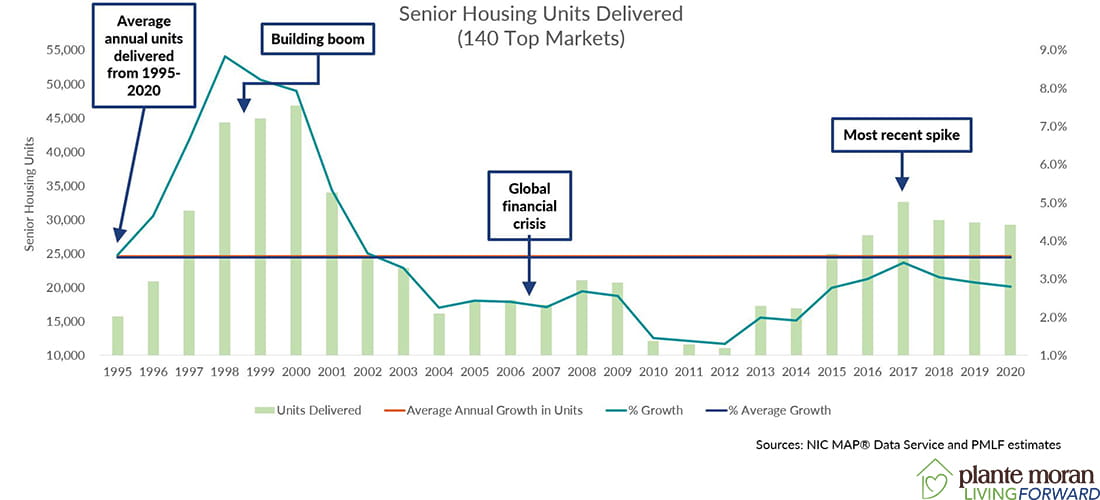The senior housing industry has seen its ups and downs over the last quarter century.
In the late 1990s to early 2000s, there was a building boom, with annual growth rates for independent living, assisted living, and memory care units delivered in the top 140 metros topping out at 8.8% during the heyday in 1998. A steady decline in new units preceded the global financial crisis, which in turn had a crippling effect on units delivered in the early 2010s.
Senior living construction spiked again from 2016 to 2018, reaching a peak in 2017. Since then, the rate of construction has been declining. The COVID-led recession in 2020 is projected to limit development over the next few years, furthering this trend. We estimate that barely 22,000 units are predicted to be delivered in 2022, a continuation of the slowdown continuing throughout 2021.
What can the senior living industry expect in terms of recovery and future growth? While no one can perfectly predict the future, our market study experts have reviewed decades of senior living market data to offer a forecast of inventory supply and demand to assist with your long-term development and construction planning.

Projections of senior living unit supply
Desirability for senior living is low right now, as evidenced by low occupancy rates across the country. According to NIC MAP® Data Service, occupancy remained flat in the second quarter of 2021 after hitting record lows earlier this year.
However, this cloud does have a silver lining for senior living owners and developers. Long-term demographics trends are favorable toward development. The demand is likely to pick up as early as 2026, according to our analysis of demographic data from the U.S. Census Bureau.
Driving this demand will be the Baby Boomers. The first of this generation turns 80 in 2026, beginning a trend that will increase the 80+ cohort 115% from 13 million in 2020 to 28 million in 2040. This is compared to an 8% growth rate for the rest of the population.
At the same time the 80+ population growing, the caregiver support ratio is decreasing, from 3.61 in 2020 to 3.17 in 2040. The caregiver support ratio represents the population aged 45 to 64 divided by the 80+ population, the age cohort of family members who would presumably care for their aging relatives. With fewer caregivers, more seniors will need to seek housing and care outside of their home.
Taking into account the demographic tailwinds, it’s estimated supply growth will ramp up in the mid-2020s as developers build for the demographic-driven demand wave. To put it into perspective: In the last 20 years, actual units increased 436,000 at a 3.4% annual growth rate in the top 140 metros. If historical senior housing utilization rates continue over the next 20 years, projected units will increase 1 million at a 4.7% annual growth rate, effectively doubling senior housing demand from 2020 to 2040.
Learn from the past to be ready for the future
This senior living inventory forecast shows significant opportunity for those who can weather the immediate disruption and make strategic decisions for the future.
It’s important to keep in mind several things before getting too ahead of the trends:
First, remember that this long-term demand, while favorable, won’t be applicable across every market. Overbuilding was a significant problem during the peak years of the 1990s and 2010s and resulted in many failed projects. To understand the demand in any specific market you’re interested in — and identify development opportunities — you’ll need a market study to examine the demographics based on ZIP codes within specific counties. A market study is an analysis of the demand for and supply of senior living in a local market area. It offers in-depth, area-specific data to support new development, avoid failed projects, and provide your market the right services for the needs of its senior population.
Second, even with a market study to dive into the local demand metrics, creating a realistic development plan also requires a sophisticated understanding of the financial strategy for growth. Organizations should be careful not to take on too much debt to protect from any downside. They should also evaluate and research alternative funding sources for any new project, such as economic or development incentives and tax programs (TIF, enterprise zones, New Market Tax Credits, etc.). A clear understanding of your funding sources allows you to develop and implement a master plan that is financially feasible.
As your community prepares to position your senior housing assets to better align with future demand, keep in mind the key steps needed to set your repositioning or new development up for success. Not sure how? Give us a call or read more in these related insights:
- Three mistakes owners make during the RFP process for senior living master planning services
- Five ways to reinvent how you approach senior living construction projects
- Seven pitfalls to avoid when planning a senior living construction project
- These mistakes could end your construction before it’s begun
If your organization would like to dive further into metrics specific to a market, or wants help identifying new growth markets, reach out to Living Forward for an analysis. We’re here to help.
SOURCES: NIC MAP® Data Service, U.S. Census Bureau, and Plante Moran Living Forward



